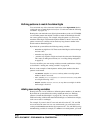
9-2 STRATA CS ADMINISTRATOR MANUAL
BETA DOCUMENT - PRELIMINARY & CONFIDENTIAL
About call routing _____________________________________
This chapter provides an overview of call routing options in Strata CS and directs
you to the chapters in this manual that explain in detail how to use them.
With Strata CS, you can route incoming calls in the following ways—you can use
one of these options or several of them in combination:
n Route calls to an auto attendant. Incoming calls go to an auto
attendant, at which callers enter an extension number. Auto attendants can
also provide a dial-by-name directory for callers who do not know a user’s
extension.
n Route a trunk directly to a user. All incoming calls on a specific
trunk go to a specified user’s phone. With this option you can send calls
to a live operator who then transfers them to users. You can also give a
user a dedicated private line.
n Ring multiple users simultaneously. Incoming calls simultaneously
ring the phones of all users in a specific workgroup. The first user in the
workgroup who answers is connected to the caller. Workgroups can
contain an unlimited number of users.
n Route calls to an automatic call distribution (ACD) workgroup.
Incoming calls are automatically put on hold in a workgroup until an agent
becomes available. Calls with the longest wait times are answered first.
See the Strata CS Call Center Administrator Guide for details of routing
within an ACD workgroup.
n Give a user a direct inward dial (DID) number. Incoming calls
reach the user without going through an auto attendant. Callers dial a
specific number that directly connects them to the user. If your phone line
supports DID, using this feature is a way to give a user a private number
without dedicating a trunk. You do not have to give DID numbers to all
users. For more information, see “ANI/DID digit collection” on page 5-5.
n Give auto attendants DID numbers. Incoming calls on any trunk are
routed to the appropriate auto attendant using the DID number that the
caller dialed. Different departments can have different phone numbers and
auto attendants (the main office, sales, support, and so forth) without
requiring many separate trunks. By assigning DID numbers to auto
attendants, you can have several auto attendants with their own phone
numbers without having to dedicate a trunk to each one.
n Route calls to a fax machine or pool of fax machines. For more
information, see “Setting up fax routing” on page 5-7.
n Route calls directly to an IVR application. In addition, users can
route calls by setting up call forwarding or using routing lists. For more
information, see Strata CS Client User Guide.


















